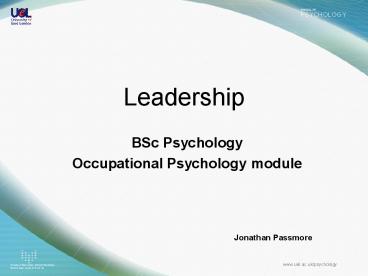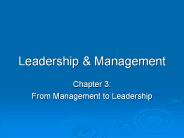Leadership - PowerPoint PPT Presentation
1 / 23
Title:
Leadership
Description:
At the end of this session and with additional reading you will be able to ... Perfectionism: they get little things right, even if big things go wrong ... – PowerPoint PPT presentation
Number of Views:94
Avg rating:3.0/5.0
Title: Leadership
1
Leadership
- BSc Psychology
- Occupational Psychology module
-
Jonathan Passmore
2
Learning outcomes
- At the end of this session and with additional
reading you will be able to - describe a selection of popular theories of
leadership - critically evaluate their conceptual approaches
- critically evaluate their utility in the
organisational setting - understand one model in detail.
3
What have these five got in common?
4
Definition
- Leadership is the process whereby one person
influences others to work towards a goal - (Yulk and Vanfleet,1992)
5
A brief history of leadership theory
- Types Great men
- Traits Behavioural Psychology
- Contingency models Situational factors
- Transactional models
- Transformational models
- Distributed leadership models
- Complexity models
6
Trait Approaches to leadership
- Lord et al (1986)
- intelligent
- extrovert
- dominant
- masculine
- conservative
- better adjusted
- Kirkpatrick and Locke (1991)
- intelligent
- desire to lead
- energy and ambition
- self confidence
- honesty and integrity
- knowledge
7
Style approaches to leadership -Lowin (1968)
- Autocratic
- direction/obedience
- close supervision
- control and accountability
- absence of participation and feedback
- Democratic
- open communication/positive attitudes
- self direction/self control
- conflict is confronted
- group based problem solving
- consensus rather than coercion
8
Contingency leadership models
- Fiedler, (1967), Trait contingency model
- Vroom Yetton, (1973) Normative contingency
model - House Mitchell, (1974) Path-Goal model
- Hersey Blanchard, (1969) Situational leadership
model
9
Kotters comparison of transactional and
transformational leadership
Source Kotter, J. A. (1990)
10
Emotional Intelligence Leadership Styles
Goleman, D. et al (2002)
11
Leading in a Culture of Change
Leaders
Members
Commitment (External and internal)
Results
More good things happen fewer bad
things happen.
Michael Fullan
12
The Context of Leadership
Far from agreement
- Enabling Performance
- Saying yes to the mess
- Encouraging connectivity
- Fostering diversity
- Challenging habits and assumptions
- Supporting initiative
- Reducing power differentials
- Keeping people motivated
- Managing Performance
- Technical/rational decision making
- Simple structures
- Effective procedures
- Monitoring/co-ordinating
- Providing direction
Close to agreement
Far from certainty
Near to certainty
After Ralph Stacey
13
Top 10 de-railing behaviours
- Arrogance they are right everyone else is wrong
- Melodrama they want to be the centre of
attention - Volatility their mood swings creates performance
swings - Excessive caution they cant make key decisions
- Habitual distrust they focus on the negative all
the time
Furnham 2005
14
Top 10 de-railing behaviours II
- Aloofness they disengage and disconnect staff
- Eccentricity they think its fun to be different
- Passive resistance their silence is
misinterpreted as agreement - Perfectionism they get little things right, even
if big things go wrong - Eagerness to please they stress being popular
matters most
15
Hogan scale
Enthusiastic - Volatile
Shrewd - Mistrusted
Careful - Cautious
Independent - detached
Charming - Manipulative
Diligent - Perfectionist
Dutiful - dependent
Confident- Arrogant
For Hogan Development Survey, see Fico, et al 2008
16
Complexity leadership
Complex
Complicated
Chaotic
Disorder
Simple
Snowden Boone, 2007
17
Understanding complex systems
- Complex systems have the following
characteristics - Large number of interacting elements
- Interactions are non-linear small things can
have big impacts - Solutions cant be imposed they emerge
- System has a history which influences present
- System appears simple ordered, but is complex
at times disordered - Constant change
- Stakeholders have multiple identifies
18
Complexity leadership
Probe, sense, respond
Complex
Complicated
Chaotic
Disorder
Sense, analyse, respond
Act, sense, respond
Simple
Sense, categorise, respond
Snowden Boone, 2007
19
Implications for leadership theory
- In Simple domains
- most people can manage
- In Complicated domains leaders need
- competencies (learned skills) to succeed
- to be able to identify the key people to solve
problems - to provide opportunities for diverse voices to
communicate share knowledge - to make decisions when demanded
20
Implications for leadership theory II
- In Complex domains leaders need to
- rely on natural abilities
- Understand the context
- Live with paradox and ambiguity
- Watch for emerging patterns
- Allow solutions to emerge based on multiple
actions/pilot schemes - In Chaotic domains
- Leaders need to act to establish order
- Work to transfer situation from chaotic to
complex
21
Further reading
- Millward, L (2003). Understanding Occupational
Organisational Psychology. P233-242. - Snowden, D., Boone, M. (2007) A Leadership
Framework Wise leaders tailor their approach to
fit the complexity of the circumstances they
face. Harvard Business Review, November 69-76. - Babiak,. P Hare, R. (2007). Snakes in suits
When psychopaths go to work. New York Harper
Collins - See also Donald Ridleys website for more
information on leadership
22
References
- , J. A. Force for Change (1990), Free Press
- Avolio, B. (2007). Promoting more integration
strategies for leadership building theory.
American Psychologist, 62(1),25-33. - Fico, J., Brady, J., Hogan, R. (2008).
Identifying potential derailing behaviours. In J.
Passmore, (Ed). Psychometrics in coaching.
London Kogan Page. - Fiedler, F. (1967). A theory of leadership
effectiveness. New York McGraw-Hill. - Fullan, M. ( 2001 ). Leadership in a culture of
change. San Francisco Jossey Bass. - Furnham, A. (2005). Icarus effect in leadership.
Conference Paper to Human Resources Development
Conference, London CIPD - Goleman, D., et al (2002) The New Leaders.
Little Brown Books. - Hersey, P., Blanchard, K. (1969). Life Cycle
theory of leadership, Training Development, 23,
26-34. - House, R., Mitchell, T. (1974). Path Goal
theory of leadership, Journal of Contemporary
Business, 3, 81-97.
23
References II
- Goleman, D., et al (2002) The New Leaders.
Little Brown Books. - Kirkpatrick, S. A., Locke, E. A. (1991).
Leadership Do traits matter? Academy of
Management Executive, 5, 48-60. - Kotter, J. A. (1990). Force for Change. New York
Free Press. - Lowin, A. (1968). Participative decision making
A model, literature critique, and prescriptions
for research. Organizational Behavior and Human
Performance. 36 683-704. - Stacey, R. (2005). Experiencing emergence in
organizations local interactions and the
emergence of global pattern (Complexity as the
experience of the organization). Abingdon
Routledge. - Vroom Yetton, (1973). Leadership decision
making. New York Wiley. - Yulk, G., Van Fleet, D. (1982). Cross
situational, multi method research on military
leaders. Organizational Behaviour and Human
Performance, 30, 87-108.































